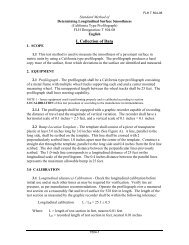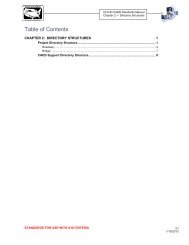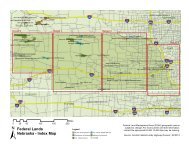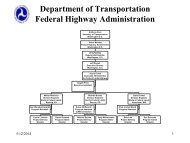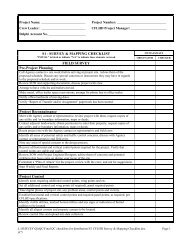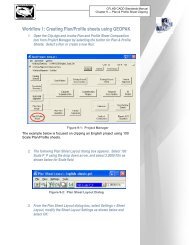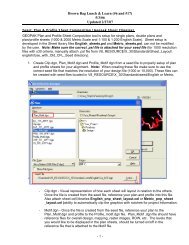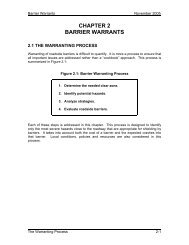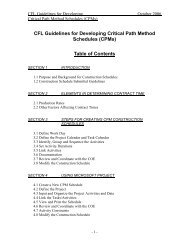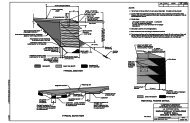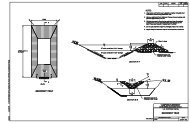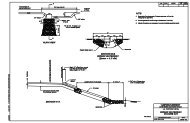Most Commonly Observed Errors for AASHTO T 308 & ASTM D ...
Most Commonly Observed Errors for AASHTO T 308 & ASTM D ...
Most Commonly Observed Errors for AASHTO T 308 & ASTM D ...
Create successful ePaper yourself
Turn your PDF publications into a flip-book with our unique Google optimized e-Paper software.
<strong>Most</strong> <strong>Commonly</strong> <strong>Observed</strong> <strong>Errors</strong> <strong>for</strong> <strong>AASHTO</strong> T <strong>308</strong> & <strong>ASTM</strong> D 6307, Asphalt Content By Ignition Furnace<br />
COMMON ERRORS PROBLEMS CAUSED BY ERROR SOLUTIONS AND SUGGESTIONS<br />
Correction factors <strong>for</strong> each mix<br />
design are calculated and given<br />
to the laboratory by the supplier<br />
of the material or a specifying<br />
agency.<br />
Since each furnace is unique, correction factors vary from<br />
furnace to furnace. Applying a correction factor that is<br />
determined <strong>for</strong> a different ignition oven furnace may lead to<br />
further inaccuracies in the test results.<br />
Whenever a laboratory begins testing on a new mix design, raw<br />
materials should be obtained from the supplier so that unique<br />
correction factors can be obtained <strong>for</strong> each furnace that will be<br />
used during testing.<br />
The correction factor used <strong>for</strong> a<br />
specific mix design is<br />
determined using another<br />
furnace in the laboratory other<br />
than the one currently used to<br />
test the mix design.<br />
Correction factors are not<br />
determined.<br />
While correction factor(s) are<br />
determined, they are not<br />
correctly applied to the test<br />
results.<br />
Correction Factors are<br />
Determined from Plant‐Mixed<br />
Samples<br />
Even two seemingly identical furnaces that operate in the<br />
same location may behave differently. Correction factors<br />
can be different <strong>for</strong> each furnace and are not related to the<br />
manufacturer or model number. Applying a correction<br />
factor that is determined <strong>for</strong> a different ignition oven furnace<br />
may lead to further inaccuracies.<br />
The asphalt content correction factor <strong>for</strong> a particular<br />
combination of furnace and job mix <strong>for</strong>mula may result in the<br />
percentage of asphalt reported to be off by as much as 1%.<br />
In addition, some aggregates may exhibit extensive<br />
breakdown during the ignition procedure, significantly<br />
changing gradation results.<br />
The loss of fine material in the ventilation system during<br />
ignition or the breakdown in aggregate particle size can cause<br />
inaccuracies in the asphalt content reported and the<br />
gradation of the aggregate sample. It is important not only<br />
to determine correction factors correctly, but also to make<br />
sure that the correction factors are applied.<br />
One of the primary purposes of the ignition furnace test is to<br />
verify the asphalt content of mixtures produced at a mix<br />
plant. The asphalt content of plant‐mixed test specimens is<br />
not accurate enough to use <strong>for</strong> correction factor<br />
determinations.<br />
To avoid having to determine correction factors <strong>for</strong> each mix<br />
design tested <strong>for</strong> every ignition furnace in the laboratory, assign<br />
certain furnaces to be used <strong>for</strong> certain mix designs only. A list<br />
of specific mix designs can be posted next to their assigned<br />
furnace and used as reference when testing. This can cut<br />
down on the time needed to determine correction factors<br />
while ensuring that the test results are still accurate.<br />
Inaccuracies in test results can be avoided by correctly applying<br />
correction factors according to <strong>AASHTO</strong> or <strong>ASTM</strong> procedures.<br />
Many ignition furnaces have a built‐in computer system where<br />
the asphalt correction factor is entered manually be<strong>for</strong>e testing.<br />
These types of furnaces will automatically account <strong>for</strong> the<br />
correction factor when reporting results. For furnaces that do<br />
not automatically take the asphalt correction factor into<br />
account, a specific location on data and calculation sheets <strong>for</strong><br />
the correction factor will help technicians to remember to use<br />
this data in their calculations.<br />
Correction factors should always be determined by use of<br />
freshly prepared laboratory‐mixed samples to ensure accuracy<br />
of the asphalt content used in the determination.<br />
Continued on Next Page →<br />
AMRL in Focus, Fall 2010 Edition “The Importance of Ignition Furnace Correction Factors” Page 1
<strong>Most</strong> <strong>Commonly</strong> <strong>Observed</strong> <strong>Errors</strong> <strong>for</strong> <strong>AASHTO</strong> T<strong>308</strong> & <strong>ASTM</strong> D6307, Asphalt Content By Ignition Furnace (Continued)<br />
COMMON ERRORS PROBLEMS CAUSED BY ERROR SOLUTIONS AND SUGGESTIONS<br />
Variation in the parent material, gradation, and particle size<br />
of aggregates used will affect the accuracy of the ignition<br />
furnace differently. Unique correction factors must be<br />
determined <strong>for</strong> each mix design tested. Even the slightest<br />
modification to a mix design (asphalt content, gradation,<br />
source, etc) should trigger the determination of new<br />
correction factors.<br />
The same correction factor is<br />
used <strong>for</strong> all mix designs tested.<br />
The “blank” aggregate<br />
correction factor sample is not<br />
sieved. Sieve analysis data is<br />
assumed to be the same at the<br />
job mix <strong>for</strong>mula percentages<br />
(Aggregate correction factors<br />
required by <strong>AASHTO</strong> T<strong>308</strong> Only).<br />
New aggregate correction<br />
factors are not determined<br />
when there is a change in<br />
aggregate type or source <strong>for</strong> a<br />
particular mix design.<br />
The correction factors are<br />
calculated incorrectly or the<br />
wrong procedure is used to<br />
determine the correction factor.<br />
The temperature or burn profile<br />
of the furnace is not adjusted if<br />
the asphalt correction factor is<br />
over 1.0%<br />
Sieve shakers and sieve analysis procedures may cause some<br />
breakdown of aggregate materials. If the “blank” aggregate<br />
sample is not sieved, the breakdown of the material from the<br />
ignition process cannot be isolated from the breakdown<br />
caused by sieving.<br />
Aggregate can vary greatly by source, and it is possible that<br />
several different types of aggregate may mined out of the<br />
same quarry. Each source and type of aggregate can behave<br />
differently in the ignition oven furnace. If a new aggregate<br />
correction factor is not determined <strong>for</strong> any change in mix<br />
ingredients, further inaccuracies in the gradation test results<br />
may occur.<br />
<strong>AASHTO</strong> and <strong>ASTM</strong> procedures and calculations <strong>for</strong><br />
correction factor determinations vary from each other.<br />
Applying correction factors determined using the wrong<br />
procedure <strong>for</strong> the version of the test per<strong>for</strong>med may result in<br />
noncon<strong>for</strong>mance to the test procedure.<br />
It is important to limit the asphalt correction factor to a<br />
relatively small percentage to avoid inaccuracies when<br />
reporting the test results.<br />
Whenever a laboratory begins testing a new mix design, raw<br />
materials should be obtained from the supplier so that unique<br />
correction factors can be obtained. It is important to make<br />
sure that the supplier or other involved party alerts the<br />
laboratory of any changes in mix design so that the correction<br />
factors can be adjusted accordingly.<br />
Both the “blank” aggregate sample and the two asphalt<br />
correction factor samples (the burned samples) must be sieved<br />
with the same sieve set and the gradation results compared.<br />
An aggregate correction should be applied to the sieve analysis<br />
results if the average difference is greater than 5% <strong>for</strong> the No. 8<br />
sieve and larger, greater than 3% <strong>for</strong> the No. 200 sieve to No. 8<br />
sieve, and greater than 0.5% <strong>for</strong> material passing the No. 200<br />
sieve.<br />
Regular communication between material suppliers and the<br />
laboratory is very important. Be sure ask the suppliers to alert<br />
the laboratory to any changes in aggregate source or type. If<br />
changes in the aggregate type or source occur, a new<br />
correction factor should be determined.<br />
The material specification should indicate whether <strong>AASHTO</strong> or<br />
<strong>ASTM</strong> procedures should be used <strong>for</strong> testing. Likewise, the<br />
correction factor(s) determined <strong>for</strong> a specific mix should be<br />
determined using the procedure specified. One way to avoid<br />
confusion is to create separate data sheets <strong>for</strong> <strong>AASHTO</strong> and<br />
<strong>ASTM</strong> correction factor determinations. It is important to<br />
communicate clearly with laboratory staff regarding the<br />
procedure that should be used to determine the correction<br />
factor(s) <strong>for</strong> each mix design to be tested.<br />
If the correction factor determined is greater than 1.0%, the<br />
temperature of convection‐type furnaces should be lowered to<br />
482±5°C. For direct IR irradiation‐type furnaces, the burn<br />
profile may need to be changed to OPTION 1.<br />
AMRL in Focus, Fall 2010 Edition “The Importance of Ignition Furnace Correction Factors” Page 2



